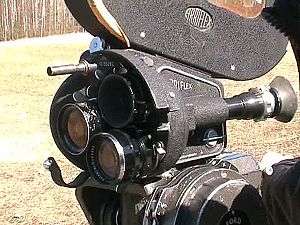Arriflex 35

The Arriflex 35 (1937) was the first reflex 35mm production motion picture camera. It was built around the spinning reflex twin-bladed "butterfly" mirror shutter designed by Erich Kästner, chief engineer at Arnold & Richter Cine Technik (ARRI), Arri Group, set at 45 degrees horizontally to the lens axis. Modern standard models have a maximum shutter exposure opening of 165 degrees, (not 180 degrees as claimed in Arri manuals), the 35 IIC-BV model having a variable shutter. The mirror shutter allows the camera operator to see a viewfinder image equal to the recorded picture, without parallax, although there is noticeable image flicker in the viewfinder when the camera is running, caused by the two open exposure segments of the mirror shutter. It is still used extensively in motion pictures for sequences without synchronous sound - "motor only sync" - and unique camera movement, e.g. on Steadicam. It was widely used with 200 ft loads (the smaller 200 ft magazine was in production at that time) as a 'battlefield camera' for the German Wehrmacht during World War II for collecting battlefront intelligence, (e.g. for analyzing weapons effectiveness), for training films and for use in propaganda cinema films.
The camera utilizes a three lens turret with three aluminum Arri lens mounts (later 35 IIC/B with one stainless steel bayonet mount and two aluminum Arri mounts), and is capable of frame rates up to 80 frames per second with an accessory speed unit. Film magazines are for 200 ft or 400 ft loads. The DC motor is mounted downwards as a handgrip. Later flat base DC motor mount units were developed e.g. by the Cine 60 company, allowing the camera to have a lower profile, where the motor is mounted on the side of the camera body vertically upwards, allowing the camera to be mounted on standard tripod heads without a special head accommodating the handgrip motor, and providing a more compact profile for 'blimping'.
New models appeared over the years: the 35 II in 1946, the IIA in 1953, the IIB in 1960 and finally, the IIC in 1964. In 1982, the II-series was superseded by the Arriflex 35-3C model, having a IIC film transport movement, a swiveling viewfinder, a quartz-driven handgrip motor, a then-new Arri PL (positive locking) lens mount and a variable shutter. The 35-3C model was put into production to use up 150 sets of 35 IIC camera movement units still inventoried at the factory.